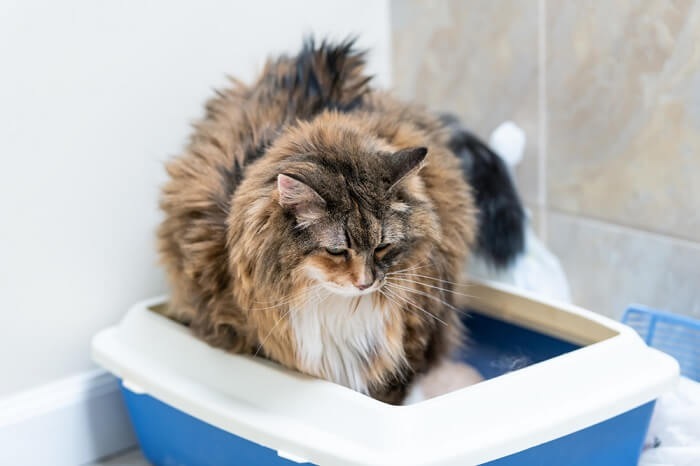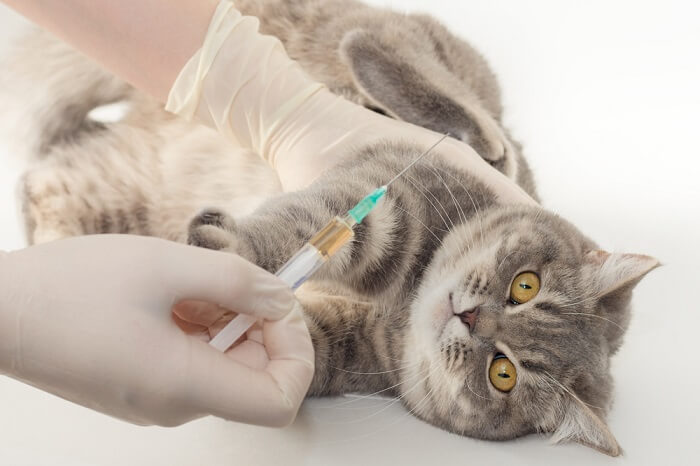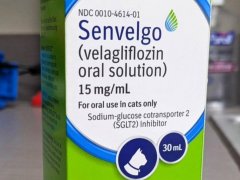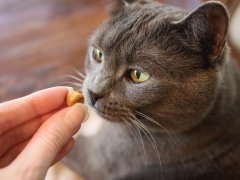
Cisapride is a promotility agent, or a medication that is used to encourage normal emptying and forward motion of digestive contents out of the stomach and through the gastrointestinal tract. It is a medication most often used to help cats with constipation or a medical condition called megacolon.
Cisapride For Cats Overview

In this article, you’ll learn more about how cisapride works, how it is prescribed, potential side effects, and some frequently asked questions.
About Cisapride for Cats
Cisapride is classified as a prokinetic or promotility agent. It is a serotonin (5-HT4)-receptor agonist, meaning it acts on serotonin receptors in the digestive tract. It stimulates smooth muscle contraction, which aids in emptying of the stomach and promoting motility of the small and large intestine.
What Does Cisapride Do for Cats?
Cisapride has been found to be useful in treating cats with recurrent constipation, and for cats with megacolon. Megacolon occurs when the nerves and muscles of the colon are no longer functioning normally.
This may occur secondary to something affecting the nerves primarily, or may be an effect seen in cats with chronic constipation or obstipation (a fecal obstruction) where the colon has been stretched to its limits so often that its muscular function is severely impaired.
By stimulating smooth muscle in the colon wall, cisapride helps the colon to move feces out and keeps it from backing up and leading to further constipation or obstipation.
Side Effects of Cisapride for Cats
Fortunately in cats, side effects appear to be few. Most common may be occasional vomiting, diarrhea, or abdominal cramping from the intestinal smooth muscle stimulation.
Because cisapride stimulates motility and pushes digestive contents along, it is extremely important that the medication is only used in the absence of a current obstruction.
For example, a cat with obstipation, or a fecal blockage, would need to have this resolved before starting cisapride. If a promotility agent is used when an obstruction is present, this may lead to worse adverse effects, and increased risk of intestinal perforation.
Cisapride should also be used cautiously in pets that also have liver disease, or any signs of bleeding from the digestive tract (either fresh blood or dark, tarry stool).
In people, cisapride was found to lead to a certain abnormal heart rhythm, or arrhythmia, prompting it to be removed as a drug for human use. This effect however, has not been documented in any veterinary medicine patients, including cats.
All the same, any cats with pre-existing heart disease may benefit from regular screening of their heart rate and rhythm while on cisapride.
Cisapride should be used very cautiously in pregnant or nursing queens.
Toxicity is uncommon when the medication is prescribed and used properly. The most common side effects reported from overdoses included diarrhea, lethargy, abnormal movements/imbalance, drooling, increased body temperature, and agitation.
Any concerns for an overdose of cisapride should be referred to a 24-hour veterinary poison consultation center, like ASPCA Animal Poison Control (1-888-426-4435) or the Pet Poison Helpline (1-855-764-7661). A fee does apply, but your vet will often need the toxicologist’s advice to help develop a treatment plan for your cat.
Lastly, cisapride can have drug interactions with several other types of medications. Always make sure to discuss any medications your cat is currently on with your vet before starting cisapride.
Cisapride for Cats Dosage

The dosage varies and depends on the condition and response, so talk to your veterinarian and follow his advice.
Cisapride is not a commercially available medication. Due to its concern for causing arrhythmias in people (which has not been shown to occur in animals), it was removed from the human market and is not available from human pharmacies.
Because it is not available commercially, cisapride can only be prescribed through a compounding pharmacy. The dosage varies and depends on the condition and response, so your veterinarian will be the best one to determine the correct starting dosage and how to adjust it.
Conclusion
Cisapride may be a helpful medication for some cats with constipation or megacolon. It is relatively safe to use in the right conditions and does not have the same concerning arrhythmia side effect in animals as seen in people.
However, because it is not commercially available and must be compounded, it can only be prescribed through an attending veterinarian familiar with a particular kitty’s condition.
Drug Dosing Disclaimer: We are only able to provide doses for medications that are FDA approved for use in cats and only as the label guidelines dictate. For medications that are used off-label we can only provide guidelines and safety information for use. Safe and appropriate dosing for off-label medications can only be determined by a primary care veterinarian.
We encourage you to work with your veterinarian to determine if a particular medication is appropriate for your cat. Changing or adjusting a dose for your cat on your own without consulting with a veterinarian can carry risk. We do not encourage use of medications prescribed for human use in pets without first consulting with a primary care veterinarian.
Frequently Asked Questions
How Long Does It Take Cisapride to Work in Cats?
Cisapride is a medication typically given every 12 hours in cats. Effects of the medication should be seen within this timeframe.
Why is Cisapride Banned?
In people, cisapride was found to cause a certain type of heart rhythm disorder, or arrhythmia, called QT-interval prolongation, and so it was removed as a commercially available medication. Otherwise, its side effects were found, even in people, to be fairly minimal.
This arrhythmia effect has not been documented in veterinary patients, and since it does appear to be very beneficial for cats with megacolon and some cases of constipation, it can still be prescribed through a veterinary compounding pharmacy.
When Can I Give My Cat Cisapride?
Only after discussing your cat’s condition with your veterinarian. It is most often used for cats with constipation or megacolon. However, not all cats with constipation need cisapride. Sometimes, certain laxative medications or a diet high in fiber is sufficient to manage constipation.
In cases of cats that get obstipated (fecal blockage) or have megacolon (where obstipation is common in untreated or poorly managed cases), a veterinarian must relieve any fecal impactions and ensure no obstruction of the GI tract is present before starting cisapride. A prokinetic/motility agent should never be used until the absence of GI obstruction has been confirmed.
How Much Cisapride Can You Give a Cat?
The dosage is very variable and depends on a cat’s particular condition and response. For example, a dose started initially may need to be gradually increased based on passage of stool. Because cisapride requires careful monitoring and because it can only be obtained through a compounding pharmacy, only your veterinarian most familiar with your cat’s condition will be able to provide proper dosing instructions.








My 15 yr old Dolce’ ..megacolon operaTion,on cisapride 2.5 + miralax Fter a yr +… has all of sudden…incontinent…and a blood spotting…but still eating + drinking…water…am worried..
Korea
Hi DJ, I wasn’t sure if you’re referring to fecal incontinence or urinary incontinence or where you feel the blood is coming from. Either way, even if your cat is acting normally otherwise, we know that many cats can hide underlying disease fairly well until a disease process worsens. It would be best to see a vet to have it evaluated.
My cat is now refusing to eat after his cisapride dose. I have been dosing him with vetasyl 15 minutes after his cisapride to put something into his colon for the cisapride to work. Is this ok?
Thank You. Your site…with the Q&A has been a big help to many of us.
Hi David,
Sorry to hear that, it sounded like you had a good routine going there for awhile. Not to sound contradictory, but recall from earlier posts that while dosing of cisapride before meals is preferred, it’s not absolutely necessary. I would consider it more important, especially with a diabetic cat, to ensure a regular, timely meal. If feeding shortly before or with cisapride will ensure Buddy eats his meal, you may have to settle for that. I would not see a problem with using the Vetasyl fiber capsules before the cisapride though.
Here I am again. My cat Buddy is on several medications and it has become difficult to get him to eat after dosing him with cisapride. I discovered tonight that I can break open his cisapride gel cap, mix it into his gravy, (along with his MiraLAX and psyllium husk), and he will not only suck the whole thing down but is hungry and wants to eat 15 or 20 minutes later without me having to do a whole lot of coaxing as I have in the past. Is this ok? Is there any reason why I should not mix the contents of the capsule with a little food or gravy as opposed to pilling him with the capsule? Thank You so much for the information on this site.
Hi David,
Glad to hear you’ve found a routine that appears to work well. I don’t think there would be any issue with what you’re doing here, and clearly your kitty is responding well. But since cisapride is a compounded medication, the best information on how a particular formulation’s absorption may be affected would be to chat with one of the pharmacists with the specific compounding pharmacy you use. There should be contact info on your cat’s medication bottle and usually a pharmacist is not too difficult to reach.
Again. Please. Is it absolutely necessary to feed 15 to 20 minutes AFTER dosing cisapride? I mean…as long as there is food in his stomach…does that really matter? He is hungry as heck…I dose him with cisapride…then won’t eat….and I need him to eat before I do his insulin injection. Help.
Hi David, sorry about the late reply! VCA Animal Hospitals gives a bit of nuance, saying that “It may be given with or without food, but if your pet vomits when dosed on an empty stomach, give future doses with food or a treat. Measure liquid forms of this medication carefully.” While the delayed meal may be ideal, it seems it should work if your cat has already been fed. You can also consult with your prescribing vet for more personalized information.
Everything I read about cisapride says wait either 15 minutes, or 20 minutes to feed. This makes dosing his other meds, and then his insulin, very challenging. I am not understanding why I cannot simply feed him immediately after his dose. How can this possibly make any difference? (My current dosing, feeding, then dosing other meds, , feeding with those meds, then the injection often takes well over half an hour, and sometimes he stress out and won’t eat which prolongs everything. Why in the world can I not dose his cisapride, his other meds, and let him eat all at once?
My 13 year old cat has megacolon. He takes 1/4tsp Miralax and 10mg Cisapride twice daily. He is having small “slipping out” of stool. I don’t believe he even knows they are slipping out. He still uses his litter box for a big job. Is the Cisapride causing this?
Hi Susan,
I wouldn’t think that cisapride would be a cause for what you’re seeing specifically. Fecal incontinence is not a listed side effect. Even if stool is being encouraged to move through the colon, the anal sphincter and rectum still hold their ground.
It can be common in cats with megacolon to have some fecal incontinence generally, but just with little bits that slip out as you said. Because of previous recurrent constipation and stretching of the colon, some of that ability to sense fecal load is lost.
That sense may still be present with large volumes of stool but less so with small pieces.
Hopefully, you’re not seeing any diarrhea. If so, the miralax could be backed down just a little bit. I usually adjust by ⅛ teaspoon at a time for fine tuning.
But generally, if your kitty is passing stool comfortably, even if there are some small surprises that slip out, this is much preferred to the alternative where we’re having trouble getting stool out at all.
It is. Thank you for the insight. He had previously been on miralax before we tried lactulose. The lactulose seems to have helped but now he seems to have taken a turn for the worse so I’m grasping at straws. I’ve not tried the combination of the two so I will ask my vet about that 🙂 Thanks again!
I started using Cisapride oral and it’s helped but the cat cannot have obstructed and gas to be evaluated for other ailments. also I do acupressure points such as inner elbow crease and spine points. research that as well. good luck
Thank you so much for the information.!8 have a rag doll who is struggling through megacolon. We have him on lactulose, cisapride, amitryptaline and prednisone. Keeping the story short, we had increased his dose of cisapride to 1 ml 2 times a day. He is 21 pounds. He seems to be struggling as he does not poop in his box. He runs around the house in fits of panic when he poops. When he pees he also seems to be uncomfortable but will still use the box. Do you have any insight into if we should adjust the dose? Or any other thoughts?
Hi Shauna,
I can’t provide much opinion on the dose of cisapride. The 1ml you mentioned is only a volume, not a dose, and since the medication can be compounded in different concentrations, you’d have to touch base with your vet to get a better opinion on adjusting the medication dosage.
If your kitty still seems to be constipated or has trouble having a bowel movement, you can ask your vet about adding in Miralax, which is an over the counter osmotic laxative. The lactulose helps to lubricate stool, but Miralax will help to pull water into the colon, softening the stool itself. We’ll typically start with an 1/8th to ¼ of a teaspoon once a day and adjust the amount or frequency (up to twice a day) as needed based on the stool consistency.
It’s usually very safe to add in with other things, but check with your vet when inquiring about the cisapride dose. I hope that’s helpful to you.
Would have helped if info was included concerning transdermal application via skin in my cat’s ear, as well as potential side effects from long term use, and use in combination with Lactulose.
?
Hi Katie,
Thanks for your comment. Unfortunately, since cisapride is only available as a compounded medication, and these can come in a multitude of forms, it isn’t possible to comment on how they compare to each other, which one is best, etc.
In many cases with forms like transdermal preparations, unless it’s an FDA approved medication (which cisapride is not), there are no clinical trials or similar studies available on how that form is tolerated, absorbed, side effects that occur particular to that form, etc.
In my experience, speaking with a pharmacist from the compounding pharmacy your medication is ordered from is the best way to get specific information about that particular drug product, including how well that form will be absorbed, it’s likelihood of efficacy compared to, say, an oral form, as well as potential side effects to look for that may be related specifically to that dosing form.
If there is no specific information on long-term side effects included in the article, then specific long-term effects are not known to be any different from the most common side effects listed. For a drug that has no consistent commercial form available and that may be made slightly different depending on the pharmacy, long-term effect studies simply are not available.
Use of cisapride in cats is based largely on anecdotal and clinical experience with it. In addition to making an inquiry with a pharmacist from the compounding pharmacy, your veterinarian may also be able to share their experience and use of it in other patients that have been on it longer.
In my own experience, lactulose is commonly used alongside cisapride. It’s goal is more to lubricate stool and help it to pass more easily. Cisapride directly impacts intestinal motility, so they are filling different roles to help with the same problem. There are no drug interactions known to occur between the two.
My cat has been on an oral form of cisipride lactulose for several years for megacolon. He is a 14 year old male tuxedo cat, which my vet says are prone to megacolon. He still must have an enema way too often, sometimes once per month. My vet has increased his dose to 1 ml twice daily before impactions got this often. At this dosage, he has gone from being the sweetest cat I’ve ever had to chasing, cornering and attacking my other cats. It is now causing one of my other cats to get so upset that she is urinating on everything and its a disaster I cannot handle. The compounding pharmacy I had used for years just stopped providing this and I’m having to switch pharmacies. Are there any other alternative treatments for megacolon? This just isn’t working that well for my cats and I’m getting desperate. My cats are ruining my house and furniture.
Hi Deborah,
I’m sorry to hear about your troubles. I can’t comment specifically on the dosage. The 1 ml volume you mention could be compounded to be any milligram dosage. Doses up to 7.5mg per cat have been described in larger cats but the adjustment is increased slowly to that point if needed.
Dosage adjustment will depend on whether cats can tolerate incrementally increased doses. The agitation and abnormal behavior you mention has been described as adverse effects seen in cats (and dogs) at higher doses. So it sounds to me that regardless of what dose your cat is currently getting, he’s not tolerating the increase very well.
One unfortunate thing with megacolon is that medical therapy does eventually fail. To my knowledge there is no other medical approach that can be tried if a high fiber diet, continued enemas and higher, more frequent doses of prokinetic medications have reached a ceiling of benefit.
But you do have a remaining option with the subtotal colectomy surgery. I think the link below, which leads to a Q & A from the Cornell Feline Health Center, would be helpful for you as it gives some perspectives on medical vs. surgical options.
https://www.vet.cornell.edu/departments-centers-and-institutes/cornell-feline-health-center/health-information/feline-health-topics/ask-elizabeth-what-there-treat-idiopathic-megacolon
Is there bad side effects with the transdermal Cisapride and or lactulose and miralax
Hi Lenora,
In general, I would expect you would see similar side effects for cisapride regardless of the dosing form, which would most often include vomiting, diarrhea, and cramping. Because cisapride can only be obtained through a compounding pharamcy, formulations may vary between pharmacies. I do not have experience with transdermal cisapride specifically. Skin irritation at the application site can be something to watch for with any topical or transdermal medication. In these cases, since there is no official standard and some variability between pharmacies, it’s always best to talk to a pharmacist from that particular pharmacy with questions about any concerns to be aware of with a particular dosing form that they make.
Transdermal forms for lactulose and miralax I don’t think would be possible, as these have to be orally ingested to work within the bowel itself. Lactulose acts as a lubricant and miralax works by drawing water into the colon. In both cases, the most common side effect is stools that are too loose or watery in which case the doses can be tapered back. Lactulose can also be a bit of a sticky mess.
Thank you for this article. We find it very helpful. We have one cat with chronic constipation, and another with chronic diarrhea. Needless to say…these two keep us very busy.
Hi Dave, I’m really glad you found the article to be helpful. Either way, chronic stool issues are not a walk in the park for sure. I appreciate the care and dedication for your kitties.
Is it really necessary to wait 15 to 20 minutes to feed after cisapride? I have other meds, food, supplements, and an insulin injection to give twice a day as well. Thank You.
Hi David,
Giving cisapride in advance of a meal is preferred, but not absolutely necessary. The idea I believe, is to stimulate movement of the colon in advance of more food being introduced. The gastro-colic reflex will stimulate movement of stool in the colon when more food is introduced to the stomach. By giving it ahead of time, it may reduce the risk of constipation occurring in cats that have poor colon motility.
You can always give the cisapride in advance of a full meal with a small treat, which may tide a kitty over the 20 minutes or so before feeding a full meal, insulin, and everything else done together. But you should only have to feed a meal one time. If you’re feeding two separate meals as it sounds from the first post, I would not see that as necessary.